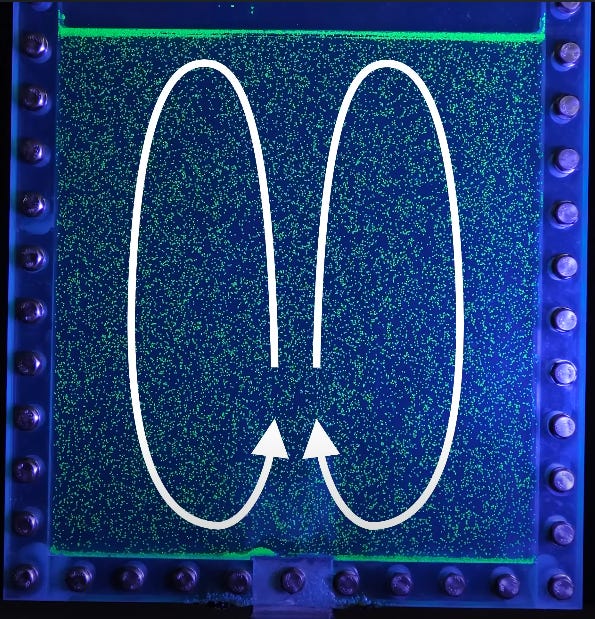Incomplete Nature Pt 4: Morphodynamic processes
How shapes survive in a world of constant change
This is part 4 of a series on Terrence Deacon’s Incomplete Nature. If you haven’t already, read part 1, part 2, and part 3 first.
Recap: In part 1, we established that ententionality—the physical embodiment of meaning, from function and sensation to morality, knowledge, and beauty—required the universe to remember how to make specific shapes. Crossing that threshold is a catch-22: to consistently make a shape, you need a consistent set of shapes to form it. In parts 2 and 3, we discussed the fundamental order vs chaos dynamic that populate the universe with shapes by generating absences. Today, we’ll introduce a type of process that can consistently manifest a shape that is very different from its equilibrium conformation and highly tunable by reshaping its surroundings.
Freezing shapes
There are really only two ways for a shape to persist in our universe, and both of them maximize entropy by spreading out energy. In Deacon’s terms, they both dissipate constraints. One of them is what you might broadly refer to as freezing. If enough energy leaves a system, constraints it used to be able to overcome will take effect. This seems like an increase in order, but only because the constraints that kept that energy inside the system have been removed. This is how we go from plasma to gas, gas to liquid, and liquid to solid. It’s also how crystals form. It even describes the formation of stars—clouds of gas literally used to be too hot for gravity to condense them into spheres.
Life relies heavily on this mode of preserving shapes. Introducing enough energy to overcome the constraints holding your cells and molecules in the right arrangements is a well-known cause of death. But the paradox of life is that it can preserve shapes by freezing them without lowering its overall temperature. It does so by taking advantage of the second way to preserve a shape: preventing the system from ever reaching equilibrium.
In an isolated system, the Second Law of Thermodynamics demands that over a long enough timescale, constraints will inevitably be removed. The only thing that can protect a shape from the incessant rearrangement of entropy is contact with the rest of the universe.
I want to start with a simplistic example of how, in a non-equilibrium condition, absence-generating constraints can create and preserve a shape. Imagine we have a box full of balloons. If we shake the box, the balloons will move around freely and fill the space, cycling through all the arrangements consistent with the equilibrium of the system. There are no constraints on the positions of the balloons, but the balloons constrain the air molecules within them, so entropy is not maximized. If we add some tacks to the box, some balloons will pop and dissipate those constraints. Absences are created and entropy increases. Shapes are destroyed and energy is even more spread out.
If those tacks are arranged in a particular way, though, we can create a new, emergent shape composed of multiple balloons in a particular relationship to each other. If we place the tacks in a ring, we can create a circle filled with balloons. If we place them only on the left side of the box, we can sort the balloons to the right. The absence of the balloons outside the edge of the shape is just as necessary for the creation of the shape as their presence inside.
If we stop shaking the box, the balloons will stop hitting the tacks and the shape will persist. If we don’t, they’ll keep popping until they’re all gone, and the shape will disappear. Unless, of course, we keep adding them at the same rate they pop. In that case, the shape will persist. As we as keep adding concentrated energy in one place and allowing it to dissipate in another, we can make any shape we want, and it will stay around indefinitely.
To be more specific, the shape it will take is the one it occupies on the way to equilibrium. A familiar example is a water fountain. By adding energy in one place, the water always maintains the otherwise-ephemeral shape it takes as it arcs to the ground.
To avoid confusing this kind of stability with the system’s equilibrium, we call such a state a dynamic attractor. This is a term from dynamical systems theory, not a Deaconism. Deacon’s addition is to name any situation that generates a shape by remaining at a dynamic attractor a morphodynamic process. Morpho meaning shape, dynamic meaning change: a process that creates a shape by endlessly reenacting a consistent sequence of changes.
Like equilibrium, morphodynamic processes emerge from the chaotic, entropic pushing toward every possible arrangement available to them due to the orthograde tendencies of their components, colliding with the absence-generating contragrade constraints that limit their arrangements. Unlike equilibrium, morphodynamic processes don’t become symmetrical over time. In the fountain, there is always more water moving downward out of the spout than upward (and vice versa in the pipe that feeds it). They maintain a spatial disparity between their orthograde impetus and contragrade constraints.
Morphodynamic processes are ubiquitous in the universe. They occur wherever energy is persistently released from a single source and spread out through some other medium. Convection cells are perhaps the most common and important example. Heat generated by fusion in the center of the sun, or by fission in the Earth’s core, spread out through the fluid layers above them, providing orthograde impetus that causes particles to rise away from the core. These particles collide with others, which also rise, and eventually the energy reaches the surface. By that point, it has spread out across many particles, so each particle is relatively cold. Few of them have the energy to overcome intermolecular attraction and escape gravity. Some of this heat can be radiated into space as light (mostly not visible light), which cools the particles even further, and since they have less energy, they can no longer resist gravity and they begin to fall back downward.
The perhaps unexpected thing about this process is that even if heat is applied nearly uniformly, the rising and falling will separate themselves into distinct “lanes” that feed into each other and persist over time, like a conveyer belt (there’s a great demonstration of this in a recent Steve Mould video). Even the slightest variations in the initial condition cause differences that give one region a head start. The places where particles have risen the quickest draw create gaps, and other particles nearby get pushed into those gaps, and when they do, other gaps are opened for the cooling particles at the top to start to fall into, so by the time other places on the bottom have become hotter, they face more resistance from cooler particles already moving downward.
As long as the same conditions are applied, a morphodynamic process will produce the same shape. When water flows down a river channel, it will always follow the same path. Some orthograde processes even manifest their own internal resistance to change. A convection cell has collective inertia. Slight fluctuations in its heat source don’t immediately change the overall shape of the cell, because the particles are already moving. The convection cell can, to some extent, capture ephemeral variation and perpetuate it against future perturbation. This ability to resist future change is why the state is called an “attractor.” It represents the emergence of a new, higher-level orthograde tendency, and unless a sufficiently strong counter-push comes along, the system will continue going through the same sequence of changes over and over again, generating a constant flow of new absences in the same particular regions, and producing the same overall shape.
In a chaotic universe, fluctuations strong enough to overcome that inertia come along all the time. Once they do, the system can only return to its prior state if the prior conditions return, and the system has no way to restore those conditions itself. If a storm erodes a new path in the river channel, going back to normal rain levels won’t bring that constraint back. Morphodynamic processes can maintain a shape that imposes a consistent constraint on their surroundings, but only as long as their surroundings impose consistent constraints on them. Because they are non-equilibrium phenomena, they cannot impose the constraints that would preserve themselves. Their shape is a byproduct of their self-dissipating tendency.
The universe is full of morphodynamic processes, from the fluid dynamics of gases and liquids to crystallization to convection cells to the gravitational interactions forming accretion disks and spiral galaxies and the cosmic web. All of them are unstoppable freight trains of constraint dissipation that last only as long as their initial conditions persist. None of them perpetuate constraints beyond those conditions, so none of them enable ententionality.
On Earth, though, things are different. Here, morphodynamic processes relate to each other in a specific way that doesn’t occur anywhere else: they mutually impose constraints on each other. This seems simple enough that it’s hard to believe it never happens anywhere else. It’s like the universe is full of hands but Earth is the only place they clap. In the next post, we’ll talk about Deacon’s speculations about how this threshold might have been crossed on Earth and why it never happened elsewhere.



